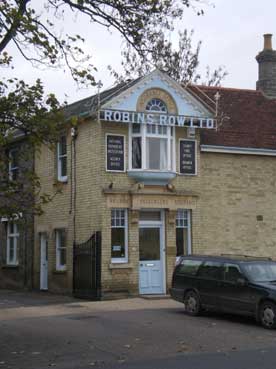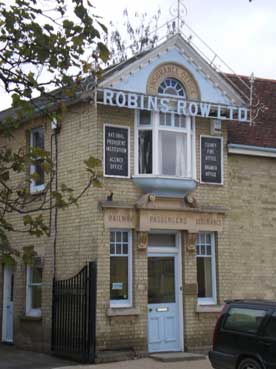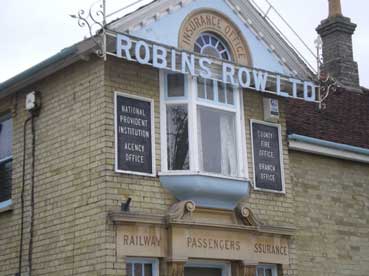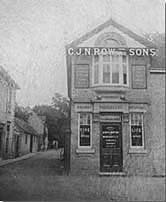Long Melford
Long Melford near Sudbury is reputed to be the longest
village in the country with its antique shops, houses, pubs and
restaurants strung along the main road in a very early example of
ribbon development. Opposite the public library we glimpsed a single
example of historic lettering so good it deserves three images.

'INSURANCE OFFICE [carved in a semicircle in
the apex]
ROBINS ROW LTD [in cut out metal letters mounted
on a decorative
wrought iron framwork around the whole gable]
NATIONAL PROVIDENT INSTITUTION
AGENCY SERVICE,
COUNTY FIRE OFFICE
BRANCH OFFICE, [these two in white condensed caps on black rectangular
panels with white frames either side of the upper bay window]
RAILWAY PASSENGER ASSURANCE [carved into the decorative
stone
architrave above the front door and windows]'
All capitals and all sans serif.
 -
-
Wonderful.
This business still operates from
this address, which is a pleasant surprise. Here's a period photograph
with differing metal lettering (C.J.N. ROW & SONS) and additional
lettering on the window and door glazing:

The company's website (http://www.robinsrow.com/) contains a potted
history from which we quote:
"In 1867 a station-master's pay was so small that Mr. C. J. N. Row had
to supplement his income by selling accident insurance to his railway
passengers. In the ensuing years the firm developed many more agencies
and eventually became C. J. N. Row & Sons when the founder took his
son into the business. Throughout the first part of the last century
the company prospered, building an enviable reputation for courteous
and practical insurance advice within the Suffolk farming community -
even though the staff were quite likely to be found playing football in
the office when the "Guvnors" were at Bury Market!
In 1951, Charles Row, the founder's grandson took over as manager
and ten years later the firm became a limited liability company. During
this period Mr. Row took in three partners Messrs. Hall, Crick and
Jackson, each of whom had more than 20 years experience with the firm.
Sadly this happy arrangement only lasted until 1967 the company's
centenary year, when the last link with the Row family was lost due to
Charles' sudden death. Undaunted the business continued to be very ably
managed by Stanley Hall and Geoff Jackson and it was only anno domini,
which finally persuaded them to look for a sympathetic suitor.
In 1988, the business was acquired by an East Anglian farming
consortium, but headed by a non-farmer Richard Robins, whose family
firm of Lloyds brokers was formed in 1917. The company changed its name
to Robins Row Ltd in 1990. In the past few years, the turnover has
increased substantially due to acquisition and the hard work of the
staff and support from local connections.
The company now has three offices. In addition to the well known
"Insurance Office" in Long Melford, Robins Row has a small but able
team at their office in Basingstoke, Hampshire. The company has also
recently aquired Worrell Fry Limited based in Bognor Regis, West
Sussex."
Here's a little information about Long Melford station from
http://www.subbrit.org.uk/sb-sites/stations/l/long_melford/index.shtml.
You can also find images of the station.
In 1846 the Colchester, Stour Valley, Sudbury & Halstead Railway
was authorised by parliament to build a 12 mile line between Marks Tey
and Sudbury. On 1.6.1847 further Acts were obtained allowing the
company to extend from Sudbury to Clare with a branch from Melford to
Bury St. Edmunds. The company was leased to the Ipswich & Bury St.
Edmunds Railway which was in turn absorbed by the Eastern Union Railway
the following month.
The line from Marks Tey to Sudbury opened on 2.7.1849 and on 1.1.1854,
the Eastern Counties Railway (ECR) took over the Eastern Union Railway.
In July 1860, the newly formed Sudbury & Clare Railway Company
revived the 1847 Act and by a new Act of July 1860 they were empowered
to build a line from Sudbury to Clare via Melford. However, as soon as
the powers were obtained, the ECR took over and immediately sought
extended powers to build from Sudbury to Shelford on the
London-Cambridge main line, plus a branch from Melford to Bury St
Edmunds.
During the period prior to the First World War, the line saw some of
its best traffic with through trains between Cambridge and Clacton via
Sudbury as well regular freight trains.
The line from Sudbury to Shelford eventually closed entirely on
6.3.1967, with the station buildings being used as residential
accomodation.

 -
-
